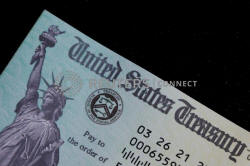|
U.S. Treasury Department guidance is also expected to clarify
states' ability to cut taxes and may address using stimulus
money to pay off debt.
The $1.9 trillion American Rescue Plan Act, signed by President
Joe Biden in March, allocates $350 billion for states,
municipalities, counties, tribes, and territories to help repair
their coronavirus-damaged budgets and economies. The federal
government has a tight deadline to start distributing the money.
"The clock is certainly ticking. They have to get the money out
the door by May 10," said Mark Ritacco, government affairs
director at the National Association of Counties.
Unlike the $150 billion governments received under last year's
federal CARES Act, which was limited to pandemic-related
spending, the new money can be used to replace revenue lost due
to the pandemic, provide "premium pay" for essential workers,
and to invest in water, sewer, and broadband infrastructure,
according to the U.S. Treasury.
Governments have "tons and tons of questions" about eligible
uses for the money including financing other capital
improvements that were deferred due to the pandemic and parking
stimulus funds in interest bearing accounts, according to Emily
Swenson Brock, director of the Government Finance Officers
Associationís Federal Liaison Center.
"There's just this wide berth of interpretation in the
(legislative text) and that's why we're a little anxious to see
if the Treasury guidance makes limitations or if it allows for
greater opportunity," she said.
Brock added that several state legislatures are talking about
using stimulus money to pay off outstanding debt, a move not
addressed in the act.
New Jersey has identified bonds that could be retired in the
next few years if the state "is afforded greater flexibility,"
according to Jennifer Sciortino, spokeswoman for the state
treasurer's office.
"At this point, it is entirely unknown if the federal government
will permit us to use funds to pay off existing debts," she
said.
Illinois Governor J.B. Pritzker wants to use stimulus dollars to
take out the remainder of the $3.2 billion his state borrowed
last year through the U.S. Federal Reserve's Municipal Liquidity
Facility to ease a cash crunch.
The act does not allow the money to be used for pensions or to
subsidize new state tax cuts.
The latter prohibition sparked five lawsuits against the Biden
administration by Republican attorneys general in several
states. Ohio filed the first case on March 17, contending
"Congress lacks constitutional authority to limit states' taxing
power in this manner."
With the case still pending, the Ohio House of Representatives
on Wednesday approved a 2% income tax cut totaling about $380
million over two years.
Bills have been introduced in 16 other states as of April 6 to
cut personal or corporate income taxes, according to the
National Conference of State Legislatures.
U.S. Treasury Secretary Janet Yellen has said nothing in the act
prevents tax cuts and that further guidance would be
forthcoming.
(Reporting By Karen Pierog; Editing by Marguerita Choy)
[© 2021 Thomson Reuters. All rights
reserved.] Copyright 2021 Reuters. All rights reserved. This material may not be published,
broadcast, rewritten or redistributed.
Thompson Reuters is solely responsible for this content.

|
|




